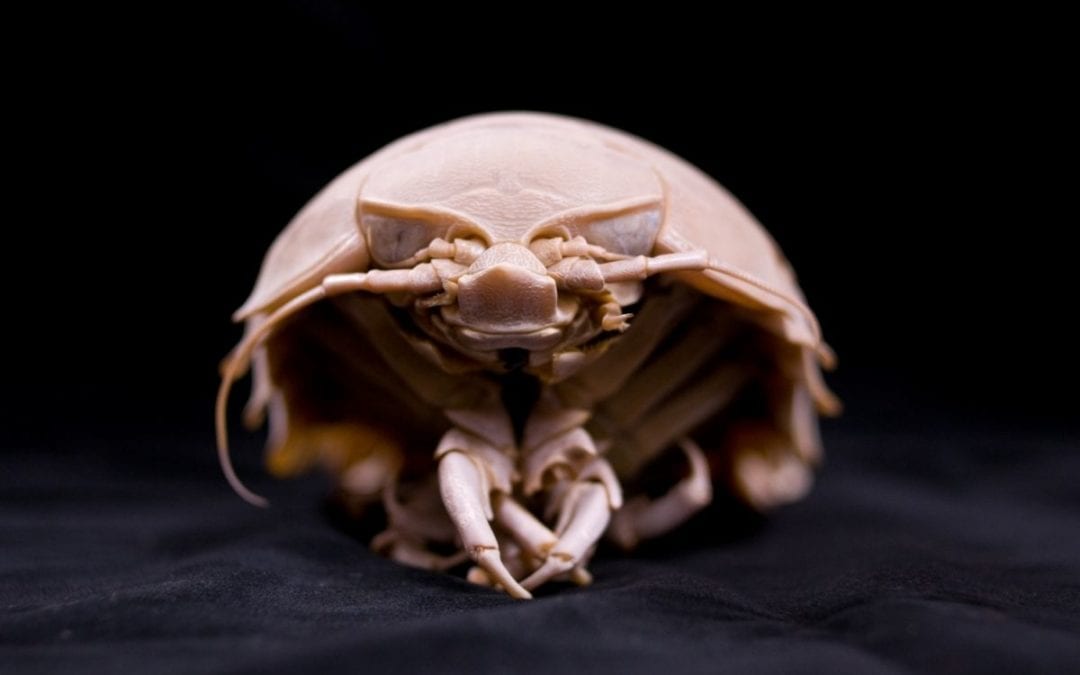I’m blaming it on Michelle from the Kentucky Board of Veterinary Examiners, but the truth is, I really don’t need help getting new pets or into something new. At least my newest pets are reasonably inexpensive and fairly low maintenance. I have several new groups of isopods.
Isopods are crustaceans. Most crustaceans (lobster, crab, others) are aquatic. A few species of isopods live on land. The only other crustaceans that are terrestrial are amphipods (think sandhoppers) and decapods (crabs, crawdads, etc).
Sounds exotic, but you’ve all seen isopods. They are the pill bugs, sow bugs or rolly pollies that live under rocks and eat decaying matter. The name means “uniform feet” and they have seven pairs of legs that all look alike.
There are about 10,000 species of isopods, but most live in the ocean or at least water. Giant isopods can be a foot and a half long and live for many years under polar ice caps. Terrestrial isopods live on land worldwide from mountains to deserts. Terrestrial isopods are critical to aid in the decomposition of plant material through mechanical (chewing) and chemical (digestive) means both of which allow more activity of microbes to recycle plant materials.
This digestion process means that isopods can be good additions to the substrate of reptiles and amphibians. They will eat leftover food, fecal matter and shed skin. The slow or unhidden isopod may also be a ready snack for the larger cage mate. They can also be kept separately as pets.
There are two species that are commonly kept. Although similar in size and appearance, pill bugs (Armadillidium) and sow bugs (Porcellio) exhibit different behaviors. When threatened, pill bugs roll into a tight ball for protection, but sow bugs run or remain still, appearing to be dead.
The terrestrial isopods have still require extra moisture like their aquatic, crustacean ancestry. Isopods lack a waxy cuticle. This makes them susceptible to drying out, but allows them to absorb moisture from the air. If there is too much moisture they drown, but not enough and they dry out. Some trial and error may be needed to get the conditions right for the particular area you are keeping the isopods.
The pH must be right also, partly because it affects microbes that are critical to digest food. Food requirements vary not only between species but between life stages of same species. This helps reduce competition between juveniles and adults for nutrients. Plant species in the detritus can make a difference in pH, microbe growth and longevity of the isopods.
Isopods don’t necessarily look alike, but they all have common features. All isopods have two pairs of antennae, compound eyes, and four sets of jaws. The body, or pereon, has seven segments, each with its own pair of walking legs. The short abdominal section has six segments, or“pleons,” and one or more of these segments is fused into a tail section. Each pleon has limbs called “pleopods.” Pleopods are used for swimming and respiration. Reproduction may not happen until the second or third year, but females can carry up to 200 eggs in a special pouch, a marsupium, located on the underside of her body. (Who knew pill bugs could live five years?)
All of this is interesting, but as Mike said when he came to pick up quail eggs, “why do people pay for these?” Considering that he paid to play with a flame thrower*, I think he should understand, but these are not just the ones you pick up under a rock. Exotic species and captive breeding have led to all sorts of variations that can be purchased at Etsy, Ebay, Amazon and reptile shows. I have orange ones, white ones with spots that are called Dalmatians and little sea ones. I have “dairy cows”, dwarf purple and orange-powder isopods on the way. If a thing is worth doing, it should be done big!
The little beggars can climb, so I have some locking storage containers on the way. They start in small containers and move to bigger ones. Getting the container set up before the isopods arrive is best because the microbes will start early. These microbes are important. The young eat the adult poop to get the right gut bacterial they need as well as nutrients released by the bacteria. Young are much more sensitive to humidity levels which is a reason for the large mortality in young. Ours are kept in a mix of potting soil, leaves and spagnam moss. They must be kept out of direct sunlight and humid, but room temperature in the seventies is fine.
So how did Michelle get me back into these? She is big into cicadas and this is a big year for them so it came up at a meeting. Later, she commented on my falconry kestrels and I said my kestrels would enjoy her cicadas. Comments were made about tacos and then Michelle said she worked with benthic macroinvertebrates at a prior job and suggested I volunteer for Kentucky River Watershed Watch (https://www.krww.org) to study our local watershed. (Turns out the health of the water stream affects the number and type of bottom-feeding critters.) I don’t have time to volunteer, but I do have time to raise some isopods. Therefore, it is obviously her fault I have new critters!
*By the way, Mike would like to point out that it was a fundraiser for medal of honor winner and a World War II flame thrower. To be fair, I probably would have paid also.

